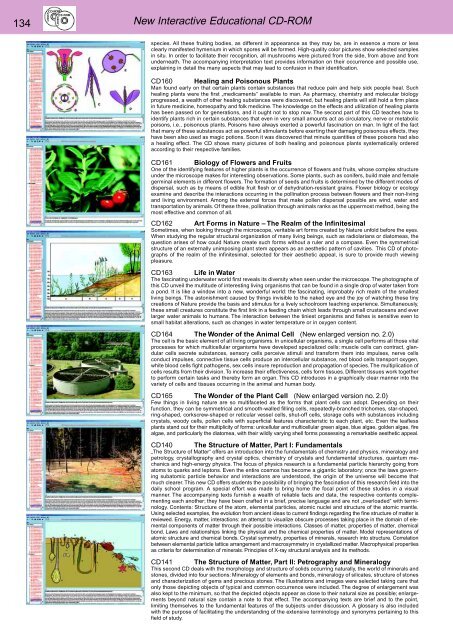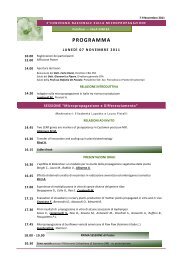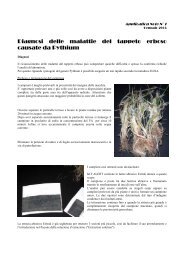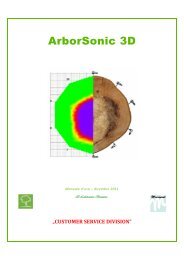BIOLOGY - microscopia.info
BIOLOGY - microscopia.info
BIOLOGY - microscopia.info
You also want an ePaper? Increase the reach of your titles
YUMPU automatically turns print PDFs into web optimized ePapers that Google loves.
134<br />
New Interactive Educational CD-ROM<br />
species. All these fruiting bodies, as different in appearance as they may be, are in essence a more or less<br />
clearly manifested hymenium in which spores will be formed. High-quality color pictures show selected samples<br />
in situ. In order to facilitate their recognition, all mushrooms were pictured from the side, from above and from<br />
underneath. The accompanying interpretation text provides <strong>info</strong>rmation on their occurrence and possible use,<br />
explaining in detail the many aspects that may lead to confusion in their identification.<br />
CD160 Healing and Poisonous Plants<br />
Man found early on that certain plants contain substances that reduce pain and help sick people heal. Such<br />
healing plants were the first „medicaments“ available to man. As pharmacy, chemistry and molecular biology<br />
progressed, a wealth of other healing substances were discovered, but healing plants will still hold a firm place<br />
in future medicine, homeopathy and folk medicine. The knowledge on the effects and utilization of healing plants<br />
has been passed on for generations, and it ought not to stop now. The second part of this CD teaches how to<br />
identify plants rich in certain substances that even in very small amounts act as circulatory, nerve or metabolic<br />
poisons, i.e., poisonous plants. Poisons have always exerted a powerful fascination on man. In light of the fact<br />
that many of these substances act as powerful stimulants before exerting their damaging poisonous effects, they<br />
have been also used as magic potions. Soon it was discovered that minute quantities of these poisons had also<br />
a healing effect. The CD shows many pictures of both healing and poisonous plants systematically ordered<br />
according to their respective families.<br />
CD161 Biology of Flowers and Fruits<br />
One of the identifying features of higher plants is the occurrence of flowers and fruits, whose complex structure<br />
under the microscope makes for interesting observations. Some plants, such as conifers, build male and female<br />
germinal elements in different flowers. The formation of seeds and fruits is determined by the different modes of<br />
dispersal, such as by means of edible fruit flesh or of dehydration-resistant grains. Flower biology or ecology<br />
examine and describe the interactions occurring in the pollination process between flowers and their non-living<br />
and living environment. Among the external forces that make pollen dispersal possible are wind, water and<br />
transportation by animals. Of these three, pollination through animals ranks as the uppermost method, being the<br />
most effective and common of all.<br />
CD162 Art Forms in Nature – The Realm of the Infinitesimal<br />
Sometimes, when looking through the microscope, veritable art forms created by Nature unfold before the eyes.<br />
When studying the regular structural organization of many living beings, such as radiolarians or diatomeas, the<br />
question arises of how could Nature create such forms without a ruler and a compass. Even the symmetrical<br />
structure of an externally unimposing plant stem appears as an aesthetic pattern of cavities. This CD of photographs<br />
of the realm of the infinitesimal, selected for their aesthetic appeal, is sure to provide much viewing<br />
pleasure.<br />
CD163 Life in Water<br />
The fascinating underwater world first reveals its diversity when seen under the microscope. The photographs of<br />
this CD unveil the multitude of interesting living organisms that can be found in a single drop of water taken from<br />
a pond. It is like a window into a new, wonderful world: the fascinating, improbably rich realm of the smallest<br />
living beings. The astonishment caused by things invisible to the naked eye and the joy of watching these tiny<br />
creations of Nature provide the basis and stimulus for a lively schoolroom teaching experience. Simultaneously,<br />
these small creatures constitute the first link in a feeding chain which leads through small crustaceans and ever<br />
larger water animals to humans. The interaction between the tiniest organisms and fishes is sensitive even to<br />
small habitat alterations, such as changes in water temperature or in oxygen content.<br />
CD164 The Wonder of the Animal Cell (New enlarged version no. 2.0)<br />
The cell is the basic element of all living organisms. In unicellular organisms, a single cell performs all those vital<br />
processes for which multicellular organisms have developed specialized cells: muscle cells can contract, glandular<br />
cells secrete substances, sensory cells perceive stimuli and transform them into impulses, nerve cells<br />
conduct impulses, connective tissue cells produce an intercellular substance, red blood cells transport oxygen,<br />
white blood cells fight pathogens, sex cells insure reproduction and propagation of species. The multiplication of<br />
cells results from their division. To increase their effectiveness, cells form tissues. Different tissues work together<br />
to perform certain tasks and thereby form an organ. This CD introduces in a graphically clear manner into the<br />
variety of cells and tissues occurring in the animal and human body.<br />
CD165 The Wonder of the Plant Cell (New enlarged version no. 2.0)<br />
Few things in living nature are so multifaceted as the forms that plant cells can adopt. Depending on their<br />
function, they can be symmetrical and smooth-walled filling cells, repeatedly-branched trichomes, star-shaped,<br />
ring-shaped, corkscrew-shaped or reticular vessel cells, shut-off cells, storage cells with substances including<br />
crystals, woody cells, pollen cells with superficial features characteristic to each plant, etc. Even the leafless<br />
plants stand out for their multiplicity of forms: unicellular and multicellular green algae, blue algae, golden algae, fire<br />
algae, and particularly the diatomea, with their wildly varying shell forms possessing a remarkable aesthetic appeal.<br />
CD140 The Structure of Matter, Part I: Fundamentals<br />
„The Structure of Matter“ offers an introduction into the fundamentals of chemistry and physics, mineralogy and<br />
petrology, crystallography and crystal optics, chemistry of crystals and fundamental structures, quantum mechanics<br />
and high-energy physics. The focus of physics research is a fundamental particle hierarchy going from<br />
atoms to quarks and leptons. Even the entire cosmos has become a gigantic laboratory; once the laws governing<br />
subatomic particle behavior and interactions are understood, the origin of the universe will become that<br />
much clearer. This new CD offers students the possibility of bringing the fascination of this research field into the<br />
daily school program. A special effort was made to bring home the focal point of these studies in a visual<br />
manner. The accompanying texts furnish a wealth of reliable facts and data, the respective contents complementing<br />
each another; they have been crafted in a brief, precise language and are not „overloaded“ with terminology.<br />
Contents: Structure of the atom, elemental particles, atomic nuclei and structure of the atomic mantle.<br />
Using selected examples, the evolution from ancient ideas to current findings regarding the fine structure of matter is<br />
reviewed. Energy, matter, interactions: an attempt to visualize obscure processes taking place in the domain of elemental<br />
components of matter through their possible interactions. Classes of matter, properties of matter, chemical<br />
bond. Laws and relationships linking the physical and the chemical properties of matter. Model representations of<br />
atomic structure and chemical bonds. Crystal symmetry, properties of minerals, research into structure. Correlation<br />
between elemental particle lattice arrangement and macrosymmetry in crystallized matter. Macrophysical properties<br />
as criteria for determination of minerals. Principles of X-ray structural analysis and its methods.<br />
CD141 The Structure of Matter, Part II: Petrography and Mineralogy<br />
This second CD deals with the morphology and structure of solids occurring naturally, the world of minerals and<br />
stones, divided into four sections: Mineralogy of elements and bonds, mineralogy of silicates, structure of stones<br />
and characterization of gems and precious stones. The illustrations and images were selected taking care that<br />
only those depicting objects of typical and common occurrence were included. The degree of enlargement was<br />
also kept to the minimum, so that the depicted objects appear as close to their natural size as possible; enlargements<br />
beyond natural size contain a note to that effect. The accompanying texts are brief and to the point,<br />
limiting themselves to the fundamental features of the subjects under discussion. A glossary is also included<br />
with the purpose of facilitating the understanding of the extensive terminology and synonyms pertaining to this<br />
field of study.







